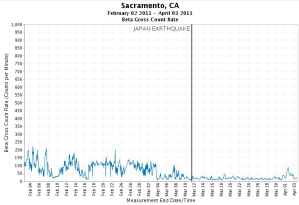The EPA re-calibrated (rigged) Japan nuclear radiation monitoring equipment causing them to report lower levels of radioactive fallout after the Fukushima nuclear meltdown than what was detected before the disaster.
Now, an investigative report looking into why the much of the EPA radiation monitoring equipment was offline when the Fukushima nuclear meltdown occurred reveals that EPA has in fact rigged radiation monitoring equipment to report lower values of radiation.
RadNet or SadNet? The EPA’s Failed Radiation Detection System
RadNet – the EPA’s front-line, radiological detection network is severely flawed and suffers from maintenance and reliability issues.
The lack of consistent data and the number of units offline (a techie term for broken) at the time they were most needed shows that the EPA was not prepared for this emergency.
Besides that fact the broken system left us all unprotected; the confusion, apprehension and fear witnessed as people try to wade through the incomplete and inaccurate data online is evidenced by an exchange on the UC Berkely website over this RadNet graph:

EPA RadNet Sacramento – As Shown Here The Radnet Monitor Was Rigged To Report Lower Levels Of Radiation Following The Fukushima Meltdown
The graph shows that this monitoring station was one of the units actually running on 3/11 . The readings were significantly higher prior to 3/11 and drop to a much lower level afterwards. This is an indication that the units were running in an uncalibrated condition and were adjusted only after the events at Fukushima.
Who is responsible for assuring that the system is up and running? The EPA contracted this responsibility to a private company, Environmental Dimensions, Inc.
Environmental Dimensions, Inc (EDI) has provided maintenance for EPA’s RadNet monitoring systems under a sole source contract which can be viewed at the end of this article. The base amount of the contract is $238,000.00. This does not include materials and travel, which is billed back to the government as needed.
The contract was awarded to what is stated as a “Woman-owned 8(a) Small Disadvantaged Business“. The disadvantaged woman in this case is EDI company president Patricia S. Bradshaw, former Deputy Under Secretary of Defense appointed by George Bush.
Could it possibly be that the corporate management at EDI formed the company not out of an altruistic sense of patriotic duty but to cash in on inside information and connections? Did Mrs. Bradshaw’s former DOD employment open the door? Did the fact that she heads a woman-owned business give her company a competitive edge?
EDI’s revenues have doubled in each of the past three years and they currently have 90 employees spread across offices in Albuquerque, Denver and Oak Ridge.
In reality, the US has seen an increase in radiation levels as evidenced by several nuclear fallout simulations, along with spikes in radiation in the drinking water, rainwater, milk, and food.
In fact, the graph above is not the only graph that is suspect either. Here are some more of the EPA RADNET radiation graphs that show drops in radiation levels, after the Fukushima meltdown, which should have shown increases.
Keep in mind, some clearly show spikes after the event but there is still a significant drop in the baseline levels of radiation. Other graphs show an unexplained drop-offs in radiation levels some time after the quake.




When I get time I will look through more of the older graphs. Right now the EPA graphs don’t go all the way back to March so the historical data is not available to see equipment re-calibration on those graphs.
Furthermore many of the graphs didn’t come online until after the disaster so there is no way to tell if the Feds rigged those monitors.

